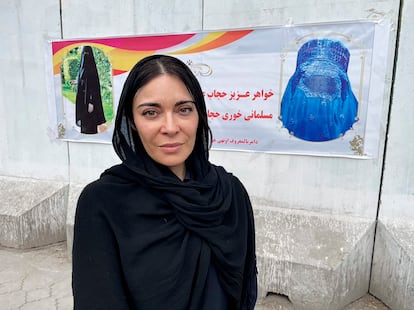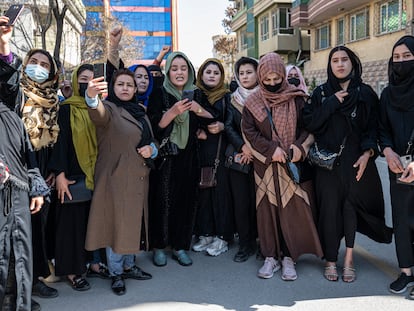The resistance of Afghanistan’s women and girls: ‘If we hide, they win’
In her documentary – ‘Afghanistan: No Country for Women’ – reporter Ramita Navai tours the country with those who defy the repression of the Taliban, and are detained and tortured as a result

On March 8, 2022, the streets of Kabul are packed with armed men. They will not tolerate demonstrations for International Women’s Day.
A group of women meets clandestinely in a local establishment. They allow themselves to be filmed and interviewed with their faces uncovered. They know that the Taliban intelligence services are watching them.
“I [protest] for my three little sisters, so that they don’t end up being subjected,” one woman affirms. “If we hide in our houses, they win.” Not hiding takes a lot of courage.
Many countries are in contention for being the worst place in the world to live. But for women, there is little doubt: it is Afghanistan. The only country on earth that prohibits the education of girls from the age of 12.
Women in Afghanistan must be invisible, covered from head to toe. Your face cannot show. You cannot travel if you aren’t accompanied by a male member of your family. Almost all women who used to have careers have lost their jobs. Many girls and women are forcibly married. There are arbitrary arrest and disappearances – torture is frequent and goes unpunished.
The invisible women of Afghanistan helped Ramita Navai – a British reporter of Iranian origin – tour the country on two separate visits. One was in November of 2021, three months after the hasty, messy departure of the last US.. soldiers. The second was in March of 2022, when the Taliban had consolidated their hold over the failed state.
Navai wanted to see if the regime had truly moderated in search of international recognition, after they last controlled the country in the late-1990s. The answer turns out to be a resounding “no.” The journey is narrated in her documentary, Afghanistan: No Country for Women.
On her first visit, in November, what had been the Ministry for Women had already been renamed Virtue and Vice Prevention. But feminist graffiti was visible on the white facade. There was still room for some kind of protest, like those organized by the fired female officials. But by March, the graffiti had been replaced by a large poster indicating how to properly wear the burqa.

The journalist passes through Kabul and peripheral cities such as Herat, where the repression is even more vicious. She learns of women who have been detained for the crime of “immorality” for months, without judicial intervention or any official record. They are prohibited from communicating with their families.
Even so – and this seems to indicate that the dictatorship is still chaotic and sloppy - Navai manages to enter one of the detention centers in search of a missing young woman. And she finds her.
Several of the detained women and girls say that they have been tortured with electric shocks from taser pistols. The reporter also collects testimonies about girls forced to marry Taliban soldiers, either in agreement with their families so that they can be released from prison, or as the result of direct kidnappings. Navai learns of victims of sexual violence, who risk being jailed if they report it.
Navai also manages to get closer to the resistance – the movement being led by the women who show their faces in front of the camera (other interviewees ask that their faces be pixelated) and refuse to give up. They organize surprised demonstrations that are quickly crushed. They have established a network of safe houses to hide persecuted women and their families while they find a way to get them out of the country.
Before leaving Afghanistan, the journalist interviews a Taliban government spokesperson and tells him everything she has seen. And he replies, without flinching or looking at her face, that nothing she says is true. The reporter – like the viewer – will do well to believe more than what she has seen with her own eyes.
Sign up for our weekly newsletter to get more English-language news coverage from EL PAÍS USA Edition
Tu suscripción se está usando en otro dispositivo
¿Quieres añadir otro usuario a tu suscripción?
Si continúas leyendo en este dispositivo, no se podrá leer en el otro.
FlechaTu suscripción se está usando en otro dispositivo y solo puedes acceder a EL PAÍS desde un dispositivo a la vez.
Si quieres compartir tu cuenta, cambia tu suscripción a la modalidad Premium, así podrás añadir otro usuario. Cada uno accederá con su propia cuenta de email, lo que os permitirá personalizar vuestra experiencia en EL PAÍS.
¿Tienes una suscripción de empresa? Accede aquí para contratar más cuentas.
En el caso de no saber quién está usando tu cuenta, te recomendamos cambiar tu contraseña aquí.
Si decides continuar compartiendo tu cuenta, este mensaje se mostrará en tu dispositivo y en el de la otra persona que está usando tu cuenta de forma indefinida, afectando a tu experiencia de lectura. Puedes consultar aquí los términos y condiciones de la suscripción digital.
More information
Archived In
Últimas noticias
Most viewed
- David King, chemist: ‘There are scientists studying how to cool the planet; nobody should stop these experiments from happening’
- Reinhard Genzel, Nobel laureate in physics: ‘One-minute videos will never give you the truth’
- Mexico completes its trade shift with the entry into force of tariffs on China and countries without trade agreements
- Oona Chaplin: ‘I told James Cameron that I was living in a treehouse and starting a permaculture project with a friend’
- Sinaloa Cartel war is taking its toll on Los Chapitos











































